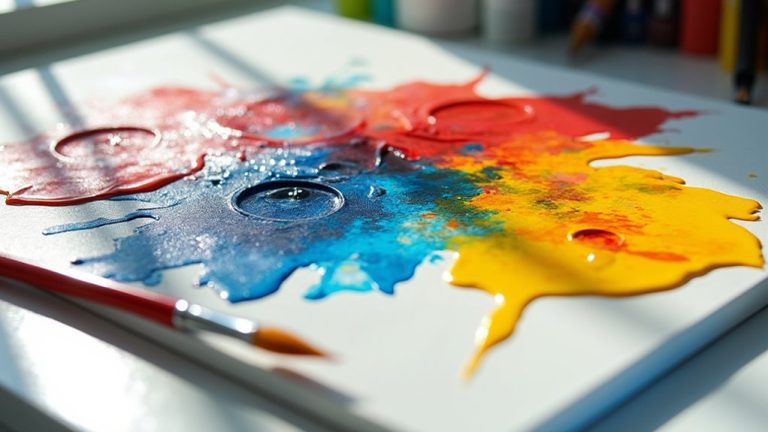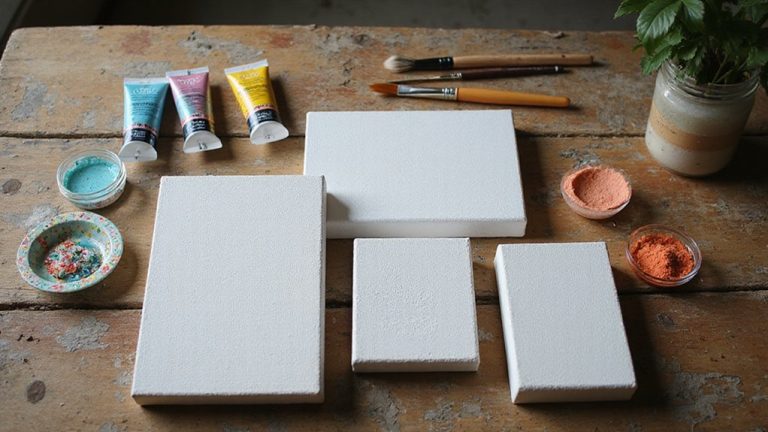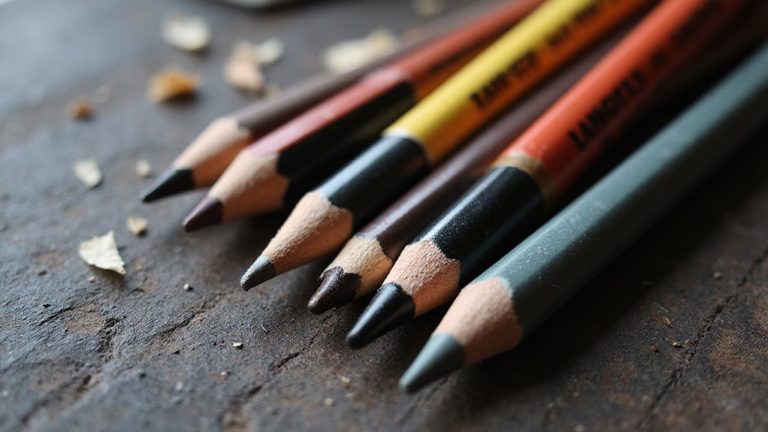5 Best Acrylic Mediums to Elevate Your Painting Game in 2025
To elevate your painting game in 2025, consider top acrylic mediums like Artecho Pouring Effects Medium (64oz), which guarantees smooth paint flow and vibrant finishes. Winsor & Newton’s Slow Drying Medium (250ml) gives you extra time for blending, while Artecho’s smaller Pouring Effects (8oz) is perfect for glossy results. Handy Art’s Matte Medium (32oz) offers a non-reflective finish, and Falling in Art’s Retarder (8oz) extends drying time for detailed work. Stick around to discover more benefits and tips!
The Essentials
- Artecho Pouring Effects Medium enhances paint flow, reduces brush strokes, and creates glossy finishes, making it ideal for artists of all levels.
- Winsor & Newton Professional Acrylic Medium doubles drying time for better blending and maintains color viscosity, perfect for detailed artwork.
- Handy Art Designer’s Palette Artist Acrylic Matte Medium offers a professional matte finish without gloss, suitable for a versatile range of applications.
- Falling in Art Acrylic Paint Retarder Medium significantly extends drying time, allowing for intricate blending while maintaining original color intensity.
- Non-toxic formulations across these mediums prioritize safety and health, making them suitable for both professional and hobbyist use in creative spaces.
Artecho Pouring Effects Medium (64oz / 1.89L)
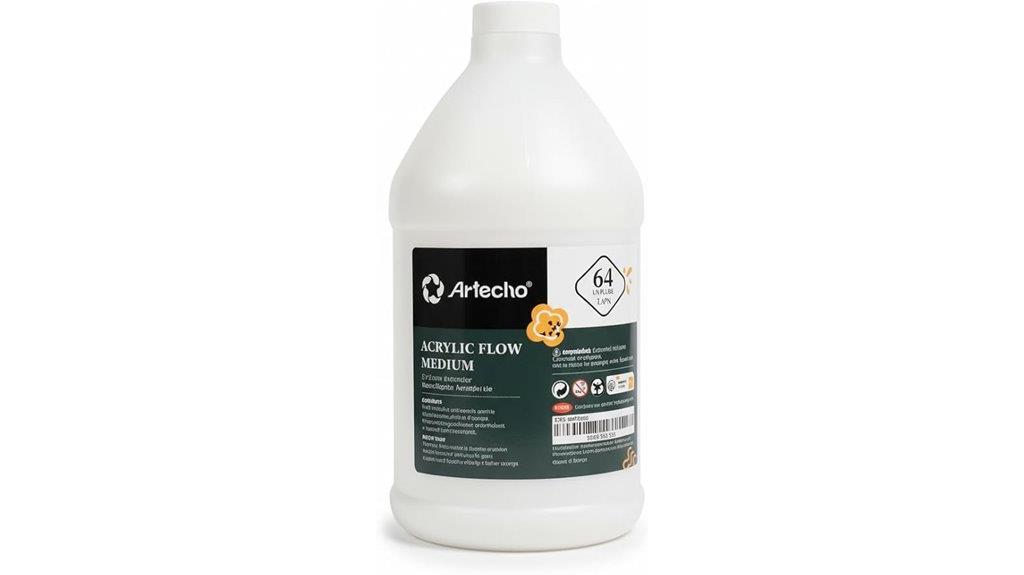
If you’re looking to elevate your painting game, the Artecho Pouring Effects Medium (64oz / 1.89L) is perfect for you. This acrylic medium reduces viscosity, ensuring your paint flows smoothly without brush strokes. Mix it with your acrylics to create stunning glazes and a glossy finish on various surfaces like canvas and stone. It’s ideal for artists at any skill level, making your artwork more vibrant and transparent. Plus, it’s non-toxic and complies with safety standards, so you can create with peace of mind. With a solid customer rating of 4.6 stars, it’s a reliable choice for enhancing your projects.
Best For: Artists of all skill levels seeking to enhance their acrylic painting with smooth, glossy finishes.
Pros:
- Enhances flowability of acrylic paints for seamless application.
- Non-toxic formula ensures safe use for artists and hobbyists.
- Versatile application on various surfaces, including canvas, board, and stone.
Cons:
- Not suitable for children under 3 years old, limiting its use in family settings.
- Requires mixing with acrylic paint, which may be a learning curve for beginners.
- Larger size may not be ideal for those who only need a small amount for occasional projects.
Winsor & Newton Professional Acrylic Medium, Slow Drying, 250ml (8.5-oz)
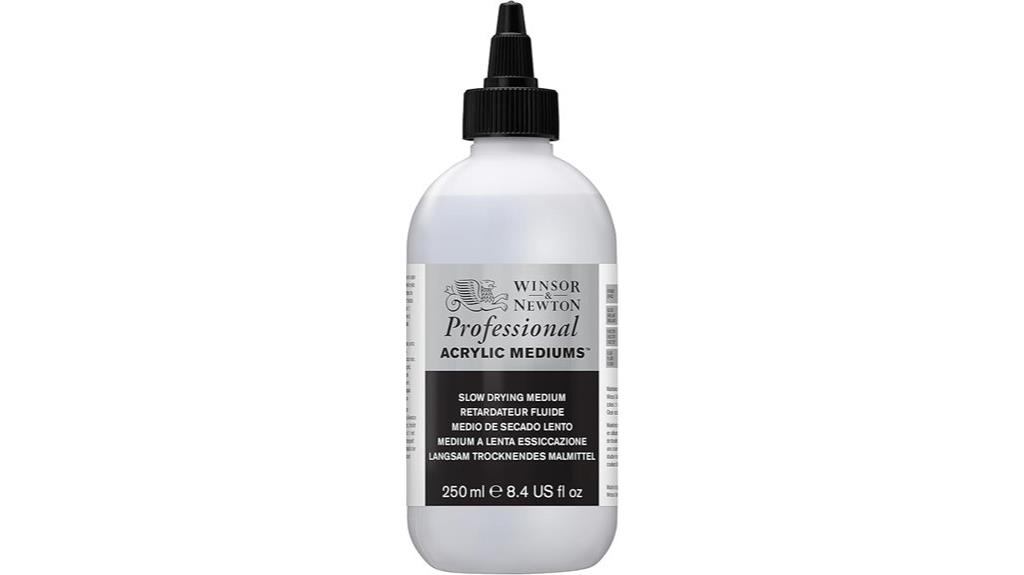
For artists seeking to master the art of blending, Winsor & Newton Professional Acrylic Medium, Slow Drying, is an excellent choice. This 250ml (8.5-oz) medium effectively doubles the drying time when mixed at a 1:1 ratio with your acrylic colors, giving you more time to manipulate and blend your paints. It maintains the color viscosity, ensuring no shift occurs from wet to dry, so your artwork stays true to your vision. With this medium, you enhance your blending capabilities and create smooth shifts, making it an essential tool for any serious acrylic painter.
Best For: Artists looking to extend their working time for blending and manipulating acrylic paints.
Pros:
- Allows for extended blending capabilities, making it easier to achieve smooth transitions.
- Maintains color viscosity and ensures no color shift from wet to dry.
- Ideal for serious acrylic painters who want to take their skills to the next level.
Cons:
- Requires careful mixing to achieve the desired drying time.
- May not be suitable for artists who prefer quicker drying times for layering.
- The 1:1 mixing ratio can dilute the paint, potentially affecting opacity.
Artecho Pouring Effects Medium for Acrylic Paint (8oz)
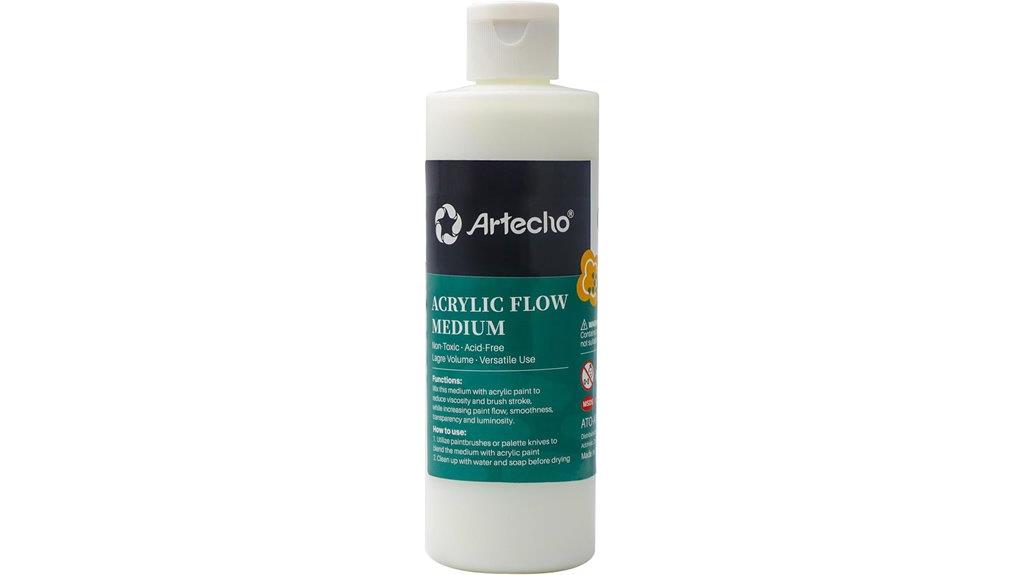
Artecho Pouring Effects Medium for Acrylic Paint (8oz) is perfect for both beginners and seasoned artists looking to elevate their painting experience. This translucent liquid simplifies your workflow by reducing viscosity and minimizing brush strokes when mixed with acrylic paint. It enhances the flowability, smoothness, transparency, and brightness of your colors, making pouring onto various surfaces a breeze. You can even apply it post-drying for a glossy finish. Just mix it with your acrylics for the consistency you desire. Ideal as a gift for painting enthusiasts, it’s versatile enough for any occasion, from birthdays to Christmas.
Best For: Artists of all skill levels, from beginners to professionals, who want to enhance their acrylic painting experience.
Pros:
- Improves flowability and smoothness of paint for seamless application.
- Suitable for various surfaces including canvas, board, and stone.
- Can be used post-drying to achieve a glossy finish.
Cons:
- Not suitable for children under 3 years old.
- May require experimentation to achieve desired consistency.
- Limited to use with acrylic paints only.
Handy Art Designer’s Palette Artist Acrylic 32 ounce, Matte Medium
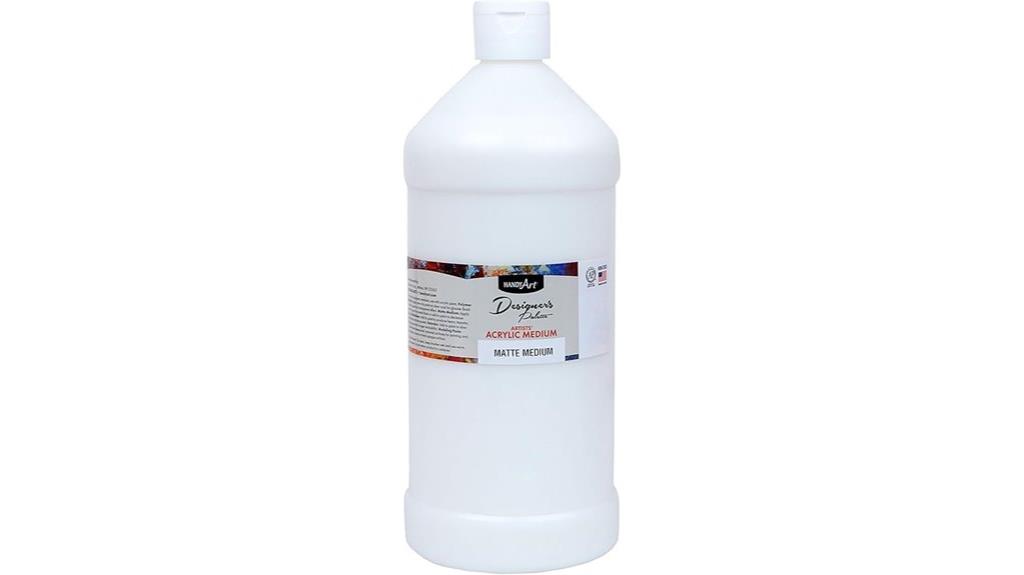
Handy Art Designer’s Palette Artist Acrylic 32 ounce, Matte Medium is an excellent choice for artists seeking a professional finish without the shine. This artist-quality acrylic medium is perfect for enhancing your artwork, allowing you to apply it over dry acrylic paint for a smooth matte finish. You can also mix it into your paint to reduce gloss, ensuring your pieces look exactly as you envision. Plus, it’s certified AP Non-Toxic and made in the USA, so you can feel good about using it. With no harmful ingredients like latex or gluten, it’s safe for any creative environment.
Best For: Artists who desire a professional matte finish on their acrylic paintings without added gloss.
Pros:
- High-quality artist acrylic medium that enhances artwork with a smooth matte finish.
- AP Non-Toxic certification ensures safety for use in any creative environment.
- Versatile application as it can be used alone or mixed with acrylic paint.
Cons:
- May require multiple applications for desired matte effect on certain colors.
- Larger size (32 ounces) may be excessive for hobbyists or casual users.
- Limited to acrylic paints, not suitable for other types of mediums.
Falling in Art Acrylic Paint Retarder Medium (8 Oz)
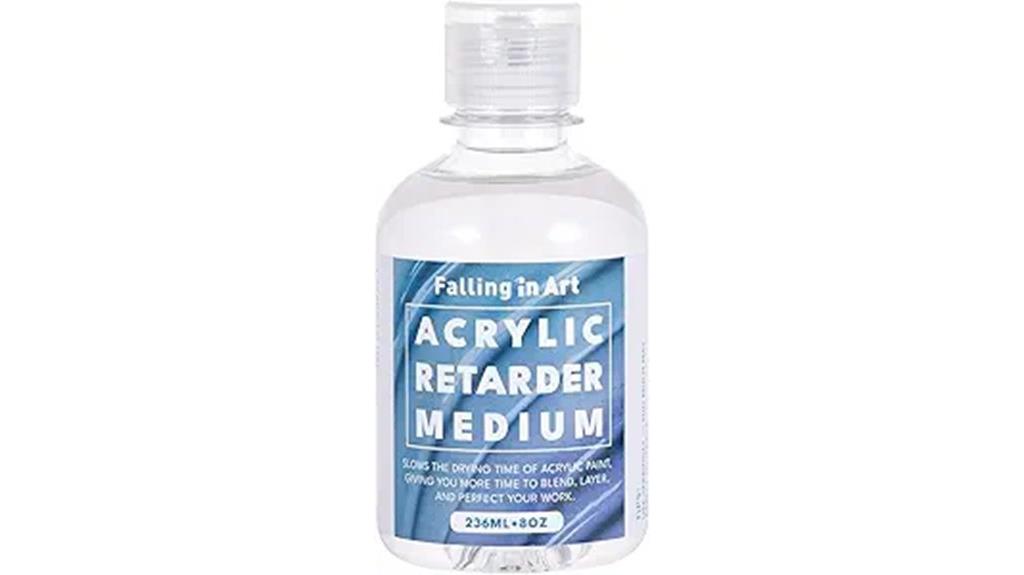
Professional artists and dedicated hobbyists will appreciate the Falling in Art Acrylic Paint Retarder Medium (8 Oz) for its exceptional ability to extend drying time. This slow-drying medium considerably slows down the drying process of your acrylic paints, giving you the freedom to blend details and create smooth gradients without the pressure of quick drying. Its non-toxic formula guarantees safety in your workspace, while maintaining the original color intensity when mixed. Ideal for various techniques, it enhances flow and open time on surfaces like canvas, wood, and paper, allowing you to achieve vibrant, uniform finishes in your artwork.
Best For: Professional artists and dedicated hobbyists looking to enhance their acrylic painting techniques with extended drying time.
Pros:
- Non-toxic formula ensures safety for studio and workspace use.
- Extends drying time significantly, allowing for detailed blending and complex adjustments.
- Maintains color integrity, ensuring vibrant and consistent finishes in artwork.
Cons:
- May require additional time for drying, which could be inconvenient for quick projects.
- Limited to acrylic paints, not suitable for other types of paint mediums.
- Can alter the texture of the paint, which may not be preferred by all artists.
Factors to Consider When Choosing Acrylic Mediums
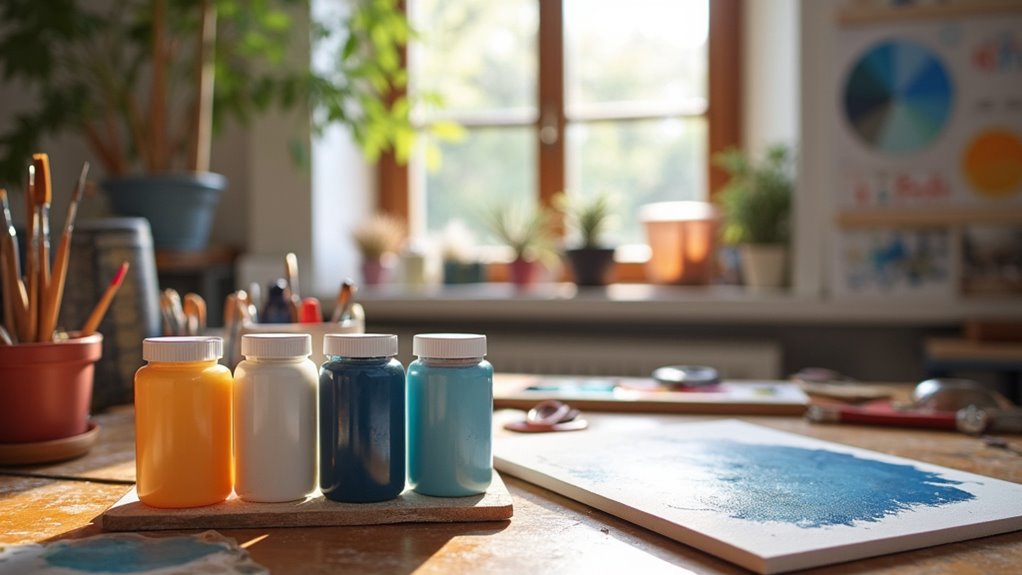
When you’re choosing acrylic mediums, consider how viscosity and flow control will impact your painting style. Think about whether you need to extend drying time or prefer a specific finish type for your artwork. It’s also essential to guarantee the medium is non-toxic and compatible with your chosen surfaces.
Viscosity and Flow Control
How do you choose the right acrylic medium to control viscosity and flow? First, consider the viscosity of the medium. Lower viscosity mediums, like pouring mediums, allow for smoother flow and blending. Products such as Artecho Pouring Effects Medium are specifically designed to enhance flowability, making them perfect for pouring techniques. It’s essential to maintain the original color intensity and consistency; some mediums can alter your paint’s appearance once dry. Additionally, the right medium can boost the transparency and brightness of your colors, affecting the overall visual impact of your artwork. Experimenting with different mediums will help you find the perfect balance to achieve the desired effects in your paintings.
Drying Time Extension
Choosing the right acrylic medium doesn’t just involve controlling viscosity and flow—it can also greatly influence the drying time of your paint. If you need more time to blend and manipulate, consider using a drying time extension medium. Typically, a 1:1 ratio of color to additive can double your drying time, giving you ample opportunity to refine your work. These mediums keep your paint’s original color and viscosity intact, ensuring your artwork’s final appearance remains consistent and vibrant. Slow-drying mediums are especially useful for techniques requiring detailed brushwork and smooth gradients, allowing for complex adjustments without the pressure of quick drying. This way, you can focus on perfecting your piece without compromising on quality.
Finish Type Preference
Since the finish type of your acrylic medium can greatly influence the overall look of your artwork, it’s essential to think about your desired aesthetic before making a selection. Acrylic mediums come in glossy, matte, and satin finishes, each offering distinct effects. Glossy finishes enhance brightness and transparency, making them perfect for vibrant artworks and glazes. On the other hand, matte mediums create a non-reflective surface, ideal for pieces where glare might distract from the visual impact. Additionally, consider how the finish type affects texture and appearance when dry, as this influences light interaction. If you prefer more flexibility, opt for slow-drying mediums that maintain their finish while extending your working time for blending and manipulation.
Non-Toxic Formulation Importance
When selecting acrylic mediums, prioritizing non-toxic formulations is essential for your health and safety. These options are especially important in spaces where children or sensitive individuals might be present. Many non-toxic mediums conform to safety standards like ASTM D-4236 and EN 71-3, ensuring they’re free from harmful substances. By using these products, you’ll reduce the risk of respiratory issues and skin irritation linked to toxic chemicals. Non-toxic acrylics are gaining popularity among both professional artists and hobbyists, allowing you to create in a healthier workspace without sacrificing quality. Additionally, choosing non-toxic mediums supports environmentally friendly practices, as they tend to have a lower impact on air and water quality compared to traditional supplies.
Surface Compatibility
Acrylic mediums are versatile and can be applied to various surfaces, including canvas, board, stone, and paper. When choosing a medium, consider how it affects your artwork’s finish—whether you’re aiming for glossy, matte, or semi-gloss results. Some mediums enhance flowability and transparency, making them ideal for techniques like pouring or glazing. It’s essential to guarantee compatibility with your chosen substrate since this impacts both adhesion and durability. A medium that alters texture or drying time can also influence how colors blend and layer on different surfaces. Always test your mediums on a small area first to see how they interact with your specific materials, ensuring you achieve the desired outcome in your artwork.
Mixing Ratios
Understanding the right mixing ratios for acrylic mediums is key to achieving your desired effects in painting. The ratio you choose can greatly impact the drying time and flow of your paint. For instance, using a slow-drying additive often recommends a 1:1 ratio with color, effectively doubling the drying time. If you’re working with a pouring medium, the specific mixing ratio is vital to achieve the right flow and transparency. Always follow the manufacturer’s guidelines, as too much medium can alter color intensity and finish. Start with smaller amounts of medium and adjust the ratio gradually to find the perfect consistency. Each medium has unique instructions, so understanding these ratios is essential for effective artwork creation.
Artist Skill Level
Choosing the right acrylic medium can greatly impact your painting experience, especially based on your skill level. If you’re a beginner, pouring mediums can simplify your process, enhancing flowability and smoothness without needing extensive experience. For intermediate artists, mediums that extend drying times allow for detailed blending and manipulation, giving you the freedom to perfect your work without rushing. As an advanced artist, you’ll want specialized mediums that maintain color integrity and viscosity, offering versatility for various techniques and complex adjustments. It’s essential to reflect on your skill level; knowing the differences in mediums helps you select the right tools that align with your unique painting style and desired outcomes.
Frequently Asked Questions
Can Acrylic Mediums Be Mixed With Other Paint Types?
Yes, you can mix acrylic mediums with other paint types like oil or watercolor, but be cautious. Each medium behaves differently, so testing small amounts first helps guarantee compatibility and desired effects in your artwork.
How Do I Clean Brushes After Using Acrylic Mediums?
You can clean brushes after using acrylic mediums by rinsing them in warm, soapy water immediately. Gently work the bristles with your fingers, then rinse thoroughly and reshape before letting them dry flat.
Are Acrylic Mediums Safe for Indoor Use?
Yes, most acrylic mediums are safe for indoor use, especially those labeled non-toxic. However, it’s still wise to guarantee proper ventilation while working. Always check labels for specific safety information and recommendations.
What Is the Shelf Life of Acrylic Mediums?
Acrylic mediums typically last around 2 to 5 years if stored properly, away from heat and light. Always check for changes in texture or smell before using them in your artwork.
Can I Create Texture With Acrylic Mediums?
Yes, you can create texture with acrylic mediums! They’ll help you build layers, impasto effects, or smooth finishes. Experimenting with different mediums lets you achieve the desired texture and depth in your artwork.


